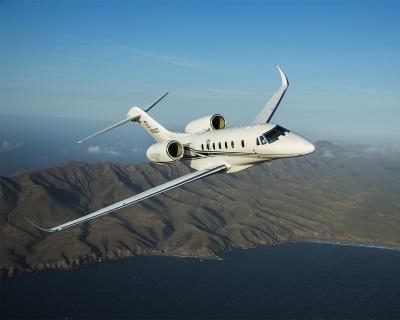Flight Followed 'Standard Flight Plan' En Route To Farnborough
Following closely behind its recent FAA certification, the Cessna Citation X+ completed its first trans-Atlantic crossing in a normal business flight profile in 5 hours, 33 minutes for an average ground speed of 502 knots.

“We filed a fairly standard flight plan to demonstrate the capability a customer can expect in normal operations, and it was very impressive,” said Kriya Shortt, senior vice president, Sales and Marketing for Textron Aviation. “While the operator will realize a huge benefit from the Citation X+ during shorter cross-country flights, long flights like this is where it really shines.”
The Citation X+ flew from the Cessna factory in Wichita, KS to Presque Isle, Maine, then 2,788 nautical miles non-stop to Cessna’s facility at Paris Le Bourget for an event. The Citation X+ then completed its journey at TAG Farnborough Airport. For the trans-Atlantic leg, the aircraft made a direct climb to 45,000 feet, accelerating to an initial cruise speed of .86 Mach, then to .88 Mach for much of the flight to Paris.
“Just as impressive as the speed of the aircraft – and the time saved – is the large cabin, the comfort, and the smart cabin technology that really make this the jet for business,” Shortt said.
The new Citation X+ has seating for up to 12 passengers, a maximum altitude of 51,000 feet, an unmatched maximum speed of Mach 0.935 (536 ktas) and an increased max range of 3,408 nautical miles.
The most distinct outward difference with the evolved Citation X+ is the addition of winglets, allowing the aircraft to cruise efficiently at higher altitudes and to consume less fuel, as well as improving takeoff and landing performance at higher elevations or on hot days. Powered by two FADEC-controlled Rolls-Royce AE3007C2 turbofan engines, the Citation X+ can fly above commercial traffic and some adverse weather at a maximum altitude of 51,000 feet.
The cockpit of the Citation X+ features ergonomic seats designed for transcontinental flights, and a dual-zone temperature control system keeps pilots and passengers comfortable. The flight deck is centered on the Garmin G5000 avionics package with four intuitive, full-color touch-screen LCD control panels and three 14-inch high-resolution displays, as well as fully integrated auto throttles to reduce pilot workload. Standard Garmin Synthetic Vision Technology on the primary flight displays gives the crew a virtual reality view of runways, terrain, traffic and obstacles.
“The pilots were thrilled by the ease of fuel management with the fully integrated autothrottle system used throughout the mission,” Shortt said. “Combined with improved aerodynamics and the addition of winglets, the Citation X+ autothrottle is the key to getting the most efficient use of fuel given the prevailing environmental conditions, and that means you save money.”
Autothrottle is integrated with the Flight Management System and Automatic Flight Control System for computer control of engine thrust, set to maximize either thrust or speed. The system can be engaged prior to takeoff roll to control fuel flow throughout a flight, from takeoff to touchdown, or disengaged for manual throttle operation.
“Under the normal flight profile we flew, air traffic control requires a constant airspeed during the crossing and without autothrottle, the pilots must constantly adjust the throttle to maintain that airspeed,” Shortt said. “With autothrottle, they set the desired speed and the airplane does the rest, greatly reducing pilot workload.”
(Image from file)
 NTSB Prelim: Lancair NLA-275-FR-C
NTSB Prelim: Lancair NLA-275-FR-C ANN's Daily Aero-Linx (09.12.25)
ANN's Daily Aero-Linx (09.12.25) Aero-News: Quote of the Day (09.12.25)
Aero-News: Quote of the Day (09.12.25) ANN's Daily Aero-Term (09.12.25): North Atlantic High Level Airspace (NAT HLA)
ANN's Daily Aero-Term (09.12.25): North Atlantic High Level Airspace (NAT HLA) Aero-News: Quote of the Day (09.13.25)
Aero-News: Quote of the Day (09.13.25)



